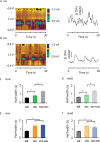Preferential enhancement of dopamine transmission within the nucleus accumbens shell by cocaine is attributable to a direct increase in phasic dopamine release events
- PMID: 18753384
- PMCID: PMC2584805
- DOI: 10.1523/JNEUROSCI.2225-08.2008
Preferential enhancement of dopamine transmission within the nucleus accumbens shell by cocaine is attributable to a direct increase in phasic dopamine release events
Abstract
Preferential enhancement of dopamine transmission within the nucleus accumbens (NAc) shell is a fundamental aspect of the neural regulation of cocaine reward. Despite its importance, the nature of this effect is poorly understood. Here, we used fast-scan cyclic voltammetry to examine specific transmission processes underlying cocaine-evoked increases in dopamine transmission within the NAc core and shell. Initially, we examined altered terminal dopamine concentrations after global autoreceptor blockade. This was the first examination of autoreceptor regulation of naturally occurring phasic dopamine transmission and provided a novel characterization of specific components of dopamine neurotransmission. Comparison of increased dopamine signaling evoked by autoreceptor blockade and cocaine administration allowed robust resolution between increased frequency, concentration, and duration of phasic dopamine release events after cocaine delivery. Cocaine increased dopamine transmission by slowed uptake and increased concentration of dopamine released in the core and shell. However, an additional increase in the number phasic release events occurred only within the NAc shell, and this increase was eliminated by inactivation of midbrain dopaminergic neurons. This represents the first evidence that cocaine directly increases the frequency of dopamine release events and reveals that this is responsible for preferentially increased dopamine transmission within the NAc shell after cocaine administration. Additionally, cocaine administration resulted in a synergistic increase in dopamine concentration, and subregion differences were abolished when cocaine was administered in the absence of autoregulation. Together, these results demonstrate that cocaine administration results in a temporally and regionally specific increase in phasic dopamine release that is significantly regulated by dopamine autoreceptors.
Figures








References
-
- Andersson JL, Nomikos GG, Marcus M, Hertel P, Mathé JM, Svensson TH. Ritanserin potentiates the stimulatory effects of raclopride on neuronal activity and dopamine release selectivity in the mesolimbic dopaminergic system. Naunyn Schmiedebergs Arch Pharmacol. 1995;352:374–385. - PubMed
-
- Aragona BJ, Liu Y, Yu YJ, Curtis JT, Detwiler JM, Insel TR, Wang Z. Nucleus accumbens dopamine differentially mediates the formation and maintenance of monogamous pair bonds. Nat Neurosci. 2006;9:133–139. - PubMed
-
- Baldo BA, Daniel RA, Berridge CW, Kelley AE. Overlapping distributions of orexin/hypocretin- and dopamine-beta-hydroxylase immunoreactive fibers in rat brain regions mediating arousal, motivation, and stress. J Comp Neurol. 2003;464:220–237. - PubMed
-
- Benoit-Marand M, Jaber M, Gonon F. Release and elimination of dopamine in vivo in mice lacking the dopamine transporter: functional consequences. Eur J Neurosci. 2000;12:2985–2992. - PubMed
Publication types
MeSH terms
Substances
Grants and funding
LinkOut - more resources
Full Text Sources
